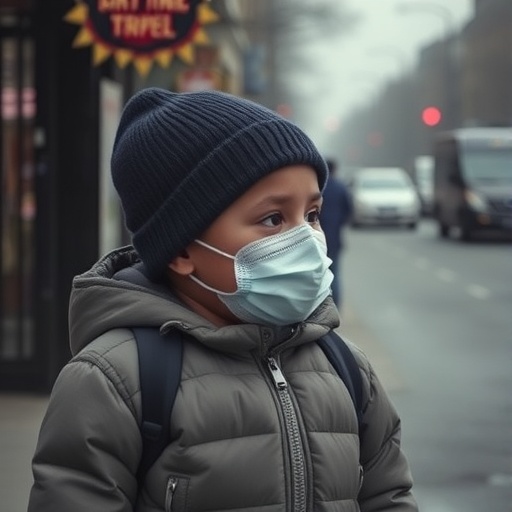
In a groundbreaking new study published in Nature Communications, researchers have uncovered profound molecular mechanisms by which air pollution exacerbates respiratory infections in children. This work, led by Brustad, Wang, He, and colleagues, delves into the proteomic landscape altered by exposure to airborne pollutants, offering a cellular and molecular explanation for the increased susceptibility of young lungs to infectious agents. As air quality continues to decline globally due to industrialization and urbanization, this research sheds critical light on the hidden biological pathways that translate polluted air into heightened disease risk, particularly in vulnerable pediatric populations.
Despite long-standing epidemiological evidence linking air pollution to respiratory illnesses, the precise molecular underpinnings had remained largely elusive. The team behind this investigation employed cutting-edge proteomic analyses to systematically chart the changes in protein expression and modification within lung tissues subjected to polluted air. Proteomics, the large-scale study of proteins and their functions, has now emerged as a powerful tool to dissect the complex interplay between environmental insults and biological responses. The study’s extensive datasets reveal a striking shift in protein networks that regulate immune function, barrier integrity, and inflammatory signaling—key components in the pathogenesis of respiratory infections.
Central to the findings is the observation that exposure to fine particulate matter (PM2.5) and noxious gaseous pollutants triggers a robust remodeling of the lung proteome in children. This remodeling impairs the innate immune defenses that typically fend off pathogenic microbes. Specific proteins responsible for pathogen recognition and clearance, including pattern recognition receptors and antimicrobial peptides, were found significantly downregulated. This downregulation diminishes the mucosal barrier’s capacity to neutralize infectious agents before they invade deeper lung tissues. Such proteomic alterations create a more permissive environment for bacteria and viruses to establish infections, explaining the clinically observed higher incidence of respiratory ailments in polluted areas.
.adsslot_TwqDUtyZ2F{width:728px !important;height:90px !important;}
@media(max-width:1199px){ .adsslot_TwqDUtyZ2F{width:468px !important;height:60px !important;}
}
@media(max-width:767px){ .adsslot_TwqDUtyZ2F{width:320px !important;height:50px !important;}
}
ADVERTISEMENT
Moreover, the study elucidates how pollution-induced oxidative stress drives these proteomic changes. Reactive oxygen species (ROS) generated by exposure to airborne toxins initiate a cascade of redox-sensitive signaling pathways that alter gene and protein expression profiles. The researchers demonstrated that the dysregulation of antioxidant enzymes and increased oxidative modifications of key immune proteins severely compromise the lung’s ability to manage microbial threats. This oxidative damage not only weakens host defenses but also perpetuates chronic low-grade inflammation, fostering conditions favorable for recurrent or persistent infections, which can severely impair respiratory development in children.
Among the most striking discoveries was the identification of altered proteins involved in epithelial barrier maintenance—structures critical for physically separating harmful agents from underlying tissues. Proteins that maintain tight junctions and mucosal scaffolding were markedly disrupted by pollutant exposure, resulting in increased epithelial permeability. This weakened physical defense permits easier penetration of pathogens and pollutants alike, heightening infection risk and inflammatory responses. The study’s multidimensional proteomic approach uniquely captured this disruption at a granular level, demonstrating how environmental pollutants hijack fundamental aspects of pulmonary biology.
The study also delves into the downstream consequences of these proteomic alterations on immune cell behavior. Proteins governing the recruitment, activation, and differentiation of alveolar macrophages and neutrophils—frontline defenders against respiratory infections—were found to be dysregulated. This immunomodulation results in impaired phagocytic activity and cytokine secretion patterns that fail to contain infections effectively. The researchers underscored the balance between protective inflammation and tissue damage, showing that pollution skews this balance towards harmful outcomes, increasing the burden of disease in exposed pediatric populations.
Importantly, the researchers utilized cutting-edge mass spectrometry techniques coupled with bioinformatics algorithms to achieve such unprecedented proteomic depth and resolution. This methodological innovation enabled profiling of thousands of proteins simultaneously, quantifying subtle but biologically meaningful changes linked to air pollutant exposure. By integrating this proteomic data with clinical phenotypes and environmental exposure metrics, the team established a compelling causal link between pollution-driven proteomic dysregulation and the heightened susceptibility of children to respiratory infections, potentially guiding future biomarker development and therapeutic strategies.
Beyond individual protein alterations, the study highlights broader network disruptions within lung cells. Pathway analyses revealed that key signaling cascades involved in cellular stress responses, apoptosis, and tissue repair are perturbed by pollution. These disruptions impede the lung’s capacity to recover from injury and promote maladaptive remodeling processes that may lead to chronic respiratory conditions beyond acute infections. This insight suggests that pollution exposure not only increases infection risk but may also prime the developing lung for long-term pathological sequelae, compounding public health challenges.
The temporal dynamics of proteomic changes in response to air pollution were also characterized. Early exposure led to rapid induction of stress response proteins and inflammatory mediators, while prolonged or repeated exposure entrenched suppressive immune phenotypes and barrier dysfunction. This temporal profiling underscores the importance of early-life exposures in setting the trajectory for respiratory health outcomes. The findings emphasize the need for stringent air quality regulations and early interventions to mitigate the lifelong impact of environmental pollutants on vulnerable children.
Complementing their molecular insights, the authors drew connections between their findings and epidemiological data showing peaks in pediatric respiratory infections correlating with pollution spikes. By providing molecular evidence linking exposure to functional immune impairment, the study bridges observational public health data with mechanistic biology. This integrative approach strengthens the argument for multidisciplinary efforts to incorporate environmental proteomics into respiratory disease research and policy development, ensuring scientific findings translate into practical health benefits.
The study also raises intriguing possibilities for developing novel diagnostics and therapeutics aimed at pollution-induced respiratory vulnerability. The identified protein biomarkers could serve as early indicators of lung compromise, enabling timely medical interventions before severe infection onset. Moreover, understanding the molecular pathways disrupted by pollution paves the way for targeted drug discovery aimed at restoring normal proteomic landscapes, bolstering lung defense mechanisms, and reducing infection frequency and severity in at-risk pediatric populations.
In conclusion, this innovative proteomic investigation unveils a previously underappreciated molecular axis underlying pollution-driven respiratory disease risk in children. By spotlighting how environmental factors reshape the lung’s proteome and immune landscape, Brustad, Wang, He, and their team provide compelling evidence for the tangible biological consequences of polluted air. This research not only advances our understanding of pediatric respiratory infections but also underscores the urgent need for public health initiatives to combat air pollution exposure, particularly in urban environments where children are at greatest risk.
As air pollution continues to be one of the leading global environmental health hazards, studies like this set the stage for a new era of environmental medicine that leverages proteomic technologies to unravel complex disease pathways. The implication of these findings extends beyond respiratory infections, offering a paradigm through which environmental insults might be mechanistically linked to diverse chronic diseases. In a world grappling with escalating pollution levels, such insights are invaluable in guiding evidence-based policies and clinical practices that prioritize child health and foster resilient communities.
The integration of environmental science, molecular biology, and clinical epidemiology embodied in this study exemplifies the multidisciplinary approach required to tackle contemporary health challenges. The novel proteomic signatures identified here offer a roadmap for future investigations into how pollution affects other organ systems and age groups. Furthermore, these discoveries may stimulate innovation in environmental monitoring and personalized medicine, enhancing our capacity to prevent, detect, and treat pollution-associated diseases with unprecedented precision.
Looking ahead, the researchers advocate for expanded cohort studies incorporating diverse geographic and demographic groups to validate and extend these findings. They also call for deeper mechanistic studies exploring how specific pollutants like heavy metals and volatile organic compounds contribute to proteomic disruptions. Together with advances in wearable exposure sensors and single-cell proteomics, such work promises to unlock new frontiers in understanding and mitigating the health impacts of air pollution, ensuring healthier futures for the world’s most vulnerable populations.
Subject of Research: Proteomic alterations induced by air pollution and their role in increasing the risk of respiratory infections in children.
Article Title: Air pollution-induced proteomic alterations increase the risk of child respiratory infections.
Article References:
Brustad, N., Wang, T., He, S. et al. Air pollution-induced proteomic alterations increase the risk of child respiratory infections. Nat Commun 16, 5930 (2025). https://doi.org/10.1038/s41467-025-61392-y
Image Credits: AI Generated
Tags: air pollution and child healthbiological pathways of disease riskenvironmental impacts on healthimmune function and pollutioninflammation and air qualitymolecular mechanisms of pollutionpediatric respiratory health risksprotein expression changes in lungsproteomic analysis of air pollutionrespiratory infections in childrensusceptibility to respiratory diseasesurbanization and health effects





